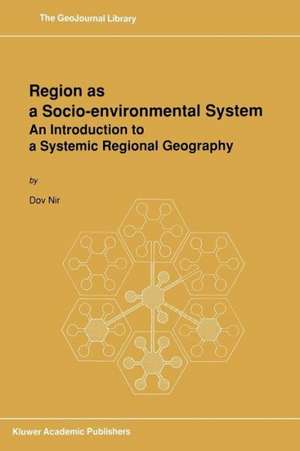Region as a Socio-environmental System: An Introduction to a Systemic Regional Geography: GeoJournal Library, cartea 16
Autor D. Niren Limba Engleză Paperback – 4 oct 2011
Din seria GeoJournal Library
- 15%
 Preț: 642.51 lei
Preț: 642.51 lei - 15%
 Preț: 632.70 lei
Preț: 632.70 lei -
 Preț: 396.78 lei
Preț: 396.78 lei - 18%
 Preț: 948.92 lei
Preț: 948.92 lei -
 Preț: 430.59 lei
Preț: 430.59 lei - 18%
 Preț: 899.69 lei
Preț: 899.69 lei - 15%
 Preț: 581.79 lei
Preț: 581.79 lei - 18%
 Preț: 938.34 lei
Preț: 938.34 lei - 18%
 Preț: 888.80 lei
Preț: 888.80 lei - 15%
 Preț: 703.85 lei
Preț: 703.85 lei - 18%
 Preț: 890.68 lei
Preț: 890.68 lei - 24%
 Preț: 777.65 lei
Preț: 777.65 lei -
 Preț: 400.65 lei
Preț: 400.65 lei - 18%
 Preț: 785.55 lei
Preț: 785.55 lei - 18%
 Preț: 946.55 lei
Preț: 946.55 lei - 15%
 Preț: 661.02 lei
Preț: 661.02 lei - 18%
 Preț: 945.79 lei
Preț: 945.79 lei - 15%
 Preț: 637.28 lei
Preț: 637.28 lei - 15%
 Preț: 637.59 lei
Preț: 637.59 lei - 15%
 Preț: 637.46 lei
Preț: 637.46 lei - 15%
 Preț: 635.31 lei
Preț: 635.31 lei - 20%
 Preț: 568.44 lei
Preț: 568.44 lei - 15%
 Preț: 645.79 lei
Preț: 645.79 lei - 20%
 Preț: 569.86 lei
Preț: 569.86 lei - 15%
 Preț: 651.99 lei
Preț: 651.99 lei - 15%
 Preț: 639.41 lei
Preț: 639.41 lei - 15%
 Preț: 643.48 lei
Preț: 643.48 lei - 15%
 Preț: 663.60 lei
Preț: 663.60 lei - 15%
 Preț: 651.99 lei
Preț: 651.99 lei - 15%
 Preț: 651.02 lei
Preț: 651.02 lei -
 Preț: 390.63 lei
Preț: 390.63 lei -
 Preț: 395.63 lei
Preț: 395.63 lei
Preț: 382.18 lei
Nou
Puncte Express: 573
Preț estimativ în valută:
73.13€ • 76.36$ • 60.39£
73.13€ • 76.36$ • 60.39£
Carte tipărită la comandă
Livrare economică 15-29 aprilie
Preluare comenzi: 021 569.72.76
Specificații
ISBN-13: 9789401067034
ISBN-10: 9401067031
Pagini: 192
Ilustrații: 182 p.
Dimensiuni: 155 x 235 x 10 mm
Greutate: 0.28 kg
Ediția:Softcover reprint of the original 1st ed. 1990
Editura: SPRINGER NETHERLANDS
Colecția Springer
Seria GeoJournal Library
Locul publicării:Dordrecht, Netherlands
ISBN-10: 9401067031
Pagini: 192
Ilustrații: 182 p.
Dimensiuni: 155 x 235 x 10 mm
Greutate: 0.28 kg
Ediția:Softcover reprint of the original 1st ed. 1990
Editura: SPRINGER NETHERLANDS
Colecția Springer
Seria GeoJournal Library
Locul publicării:Dordrecht, Netherlands
Public țintă
ResearchCuprins
Introduction: The State of the Art.- Geography, as life itself, is built on dichotomies.- Geography — art or science?.- Objectivity and subjectivity in geographical research.- Use and misuse of geography.- The systems approach as a way of thinking in regional geography.- one: Concepts of Regional Thought in Geography.- The dawn of regional thought.- The new world.- The years 1859–1953: regional geography at its perigee.- two: The ‘Quantitative Revolution’: Regional Geography at Its Apogee.- Positivistic approaches and topical studies.- Theories contributed by the quantitative revolution.- Appreciation and criticism of the ‘quantitative revolution’.- Pluralism: ‘dernier cri’ or ‘cul-de-sac’?.- Regional Sciences and Landscape Analysis.- three: Regions, Zones, Boundaries.- Concepts of region.- Defmitions and types of regions and zones.- Homogeneous and nodal regions.- Definitions of boundaries and limits.- Region and literature.- four: Region as a System.- Basical remarks on the systems approach.- Systems approach in geography.- Systems approach in regional geography.- five: Towards a Model of The Region as an Open System.- The model of Ritter and Hettner.- The ‘central problem’ model.- The model of systemic region.- Application of the model: the Region of Bet Shean, Israel.- Application of the region model to a single-feature region.- six: The Philosophy Beyond the Regional Model.- Geography, positivism and phenomenology.- Dialectical reasoning as the basis for the concept of systemic region.- seven: Methods in Regional Geography.- Air photos.- Analysis of maps.- Delimitations of boundaries.- Dealing with variables.- Distribution of variables.- Topology.- Comparison.- Comparative regional geography.- Case study.- eight: Contribution of Regional Geography to Society.- Application of regional geography in planning.- Regionalization, regionalism and regional development.- Freedom and geographical acting.- Conclusion: Commitments and Future of Systemic Regional Geography.














